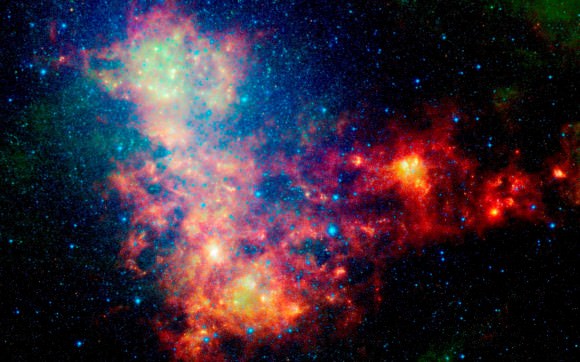Interactions.org Newsdigest 28 April 2009
Updated: 2012-06-30 19:07:14
-- Antimatter mysteries 2: How do you make antimatter? -- The great data explosion -- Big Bang machine detectors will be 'even more perfect' -- Particle physics study finds new data for extra Z-bosons and potential fifth force of nature -- That Other Theory - Loop Quantum Gravity -- Officials to break ground on cutting-edge international physics lab in Northern Minnesota

 When galaxies collide, stars are thrown from orbits, spiral arms are stretched and twisted, and now scientists say galaxies ring like a bell long after the cosmic crash. A team of astronomers from the United States and Canada say they have heard echoes of that ringing, possible evidence of a galactic encounter 100 million years [...]
When galaxies collide, stars are thrown from orbits, spiral arms are stretched and twisted, and now scientists say galaxies ring like a bell long after the cosmic crash. A team of astronomers from the United States and Canada say they have heard echoes of that ringing, possible evidence of a galactic encounter 100 million years [...] If the Higgs exists, why has discovering it taken so long – and why, if no definitive discovery is announced next week, might it continue to take even longer?
If the Higgs exists, why has discovering it taken so long – and why, if no definitive discovery is announced next week, might it continue to take even longer? Our galaxy, the Milky Way, is a large spiral galaxy surrounded by dozens of smaller satellite galaxies. Scientists have long theorized that occasionally these satellites will pass through the disk of the Milky Way, perturbing both the satellite and the disk. A team of astronomers from Canada and the United States have discovered what may well be the smoking gun of such an encounter, one that occurred close to our position in the galaxy and relatively recently, at least in the cosmological sense.
Our galaxy, the Milky Way, is a large spiral galaxy surrounded by dozens of smaller satellite galaxies. Scientists have long theorized that occasionally these satellites will pass through the disk of the Milky Way, perturbing both the satellite and the disk. A team of astronomers from Canada and the United States have discovered what may well be the smoking gun of such an encounter, one that occurred close to our position in the galaxy and relatively recently, at least in the cosmological sense. During a recent symposium at Fermilab, a speaker took the stage to defend government investment in basic science. He used an odd tactic: He called particle physics unreasonable.
During a recent symposium at Fermilab, a speaker took the stage to defend government investment in basic science. He used an odd tactic: He called particle physics unreasonable. A new crack in the Standard Model may be starting to form. Recently analyzed data from the BaBar experiment show that one type of particle decay happens more often than predicted by the Standard Model.
A new crack in the Standard Model may be starting to form. Recently analyzed data from the BaBar experiment show that one type of particle decay happens more often than predicted by the Standard Model.  It’s a mystery where ultra-high-energy cosmic rays come from and what they’re made of. But a new technique, currently in the works, could drastically improve scientists’ chances of finding out.
It’s a mystery where ultra-high-energy cosmic rays come from and what they’re made of. But a new technique, currently in the works, could drastically improve scientists’ chances of finding out.